Michel Vaillant Legendes Part 1: 'Dans l'Enfer d'Indianapolis'
The hell that is Indianapolis
Author
- Henri Greuter
Date
- December 7, 2023
Related articles
- Le Grand Défi by Jean Graton first of the Michel Vaillant comics - Some reflections and even more reflections, by Henri Greuter
- The Michel Vaillant adventure Suspense à Indianapolis - Where fantasy and reality met - and about that reality, by Henri Greuter
- The Michel Vaillant adventure Champion du Monde - The local press at Indianapolis underestimated big time, by Henri Greuter
Who?Billy Foster What?Vollstedt-Ford Where?Indianapolis When?1966 Indianapolis 500 |
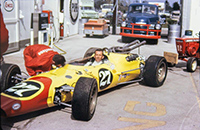 |
Why?
In the 'classic era' of Michel Vaillant adventures (the albums still created by Jean Graton) there are four albums in which the Indianapolis 500 stars as one of the races. These are, listed with their original French titles and year of publication:
- 1. Le Grand Défi – (1959)
- 11. Suspense à Indianapolis (1966)
- 26. Champion du Monde (1974)
- 28. Le Secret de Steve Warson (1975)
A fifth brief adventure dedicated to the 500 is included in the 'Steve Warson' theme book about the American racing scene published in 1972.
The Michel Vaillant publishing organisation themselves talk about le premier saison for the era that contains the albums 1 to 57. But apart from the titles listed above, Indianapolis no longer appeared in the books written by Jean Graton or the follow-ups published from number 58 up. But early 2022 came a big surprise.
MichelVaillant.com, the official website of the publishers of the latest series of Michel Vaillant adventures, announced a new series of adventures for Michel and his friends from the time that they participated in the legendary races in motorsport history. The first of these Legendes would be about the 1966 Indianapolis 500, and with the announcement came the story that the adventure would reveal what mystery took place in the race.
Original author Jean Graton died in 2021 so he was not involved with this publication. The album was to be compiled by Denis Lapière and Vincent Dutreuil.
Needless to say that yours truly eagerly awaited this adventure and was wondering what was the big story was that would be revealed in the adventure. Although a lot can be told about the 1966 race, it was not quite a race that caused many fiercely debated controversies like some more recent ones we saw in the past two, three decades. The most likely matter that was to be dealt with could be the fact that there is some controversy about Graham Hill being the true winner due to the confusion with Timing & Scoring perhaps missing out on one particular lap of Jim Clark being truly driven by him or perhaps that it was scoring error involving Jimmy's team mate.
For some time a few drawings were the only teasers to be found on the Internet, and these were raising the expectations. The kind of drawing, and their style, it all looked like coming out of a 1960s Graton adventure. For the fans of the original Michel Vaillant albums this was something to look forward to.
From what I can figure out, the French edition was released late September 2022. Interestingly enough, I found evidence on the Internet of two different versions of front covers.
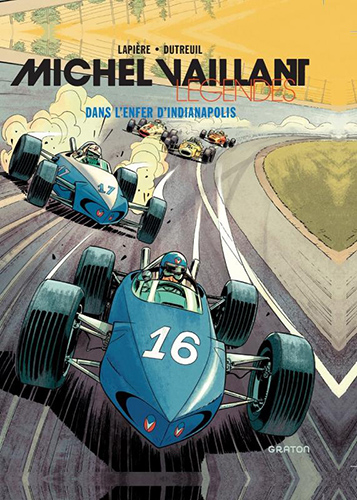
An image of the first cover version for the French edition (copyright Graton Editeurs/Dupuis)
The Dutch translation of the album went on sale in early November 2022 and this had the cover that I had seen in the pre-publication date announcements for the album.
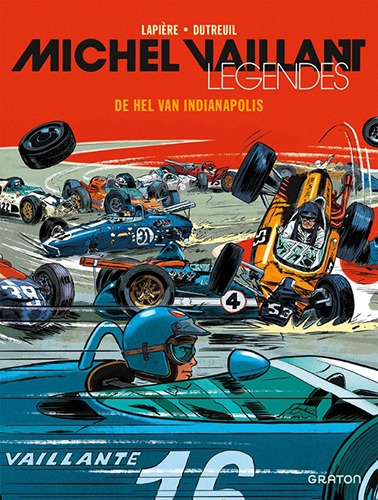
This cover version appeared in the pre-publication announcements on the internet for the Dutch versions of the album. Later on I found evidence of this particular version of the cover with the French title as well. (copyright Graton Editeurs/Dupuis)
When I finally got hold of my copy of the Dutch translation (titled De Hel van Indianapolis), I wasn't disappointed. At least not initially.
Yes, there were a few little details that made the drawings identifiable as not made by Jean Graton, but the atmosphere, the feeling was there. Although there were a few notable differences, the drawing style was very close to what is known from the classic Graton albums.
However, I could not describe in words exactly what made the album different from a genuine Graton album. Until I ran into a review of the album in a Dutch newspaper while doing my research on this adventure. The author of this review, Frank von Hebel, put it into words I could agree with, so I reproduce his phrasing in the article as good as I can from the Dutch original.
No, it's the characters I've been looking at with some raised eyebrows from time to time. Michel, Steve, Jean-Pierre, the Old Joseph, Henri Vaillant; often they are a match, but sometimes there are outliers. As if the proportions and shapes of their faces are not correct. And I've never been able to find this with Graton drawings.
Von Hebel pays attention to these differences, but since these are irrelevant for this review I won't go into this topic.
The quality of the drawings in general is like what we are familiar with from the old Graton style. But on occasion the artist has difficulty with dealing with the perspectives of the corners of the track. He wants to show that some action was taking place in one of the corners but it looks as if the corner is much more sharper and tighter than it really is.
Another near comical error is made near the end of the story when three cars are seen from above and their relative positions to another on track is shown. For two of the cars the proportions and dimensions are OK. But the third car has the driver sitting so far back in the monocoque and the engine still behind him that it appears as if the rear axle is at the level of halfway the engine.
The engine in question is an Offy and Offies are known for occasionally, and in such cases almost always unintentionally, having parts sticking out through the crankcase. But rear axles? I've never heard of such a case yet.
But then, this kind of error has been made by Jean Graton in his own albums as well so to some extent we might say that by including this kind of error the authors recreated the 'Jean Graton atmosphere' even further.
Despite the differences, I dare to say that as a reader, you are dealing with the closest to a non-Graton-drawn old-style Michel Vaillant you have ever seen.
But when I was finished reading I definitely knew that this wasn't a Jean Graton album at all because of at least one thing missing in the story of which I am certain that Monsieur Graton would have added it to the story somehow.
More seriously, the story has another thing that caused a lot of questions with me, and I am not sure if Monsieur Graton would ever have created this or a similar option.
Since this is a new album, I don't want to spoil too much about the contents and the story. And because of that, the contents of this article are a bit different compared to similar articles about the older Michel Vaillant stories I have reflected on.
First observations and conclusions
No question about the year in which the story took place, it was announced as 1966.
Vaillante brings back the cars that were a success in the 11th Michel Vaillant adventure Suspense à Indianapolis (published in 1966) for another go at the Speedway. This time the cars are numbered 16 and 17.
I won't call myself an Indy specialist because of personal experiences although I am fairly familiar with how it was at the track in the 60s. I'm sure that people with personal experience of 1966 can point out even better what is incorrect and what in the album is different from the reality of those days, but the scenery both at the track as well as elsewhere in the city of Indianapolis looks credible and genuine enough to enhance the feeling that you are reading an adventure taking place in a mid-sixties setting at Indianapolis and the Speedway.
As for the scenery outside the Speedway facilities, I can't give judgement on whether the drawings are representing actual venues or if locations entirely correct at the time. If it comes to giving the feeling of American scenery in the mid-sixties, that is most definitely the case. But if it comes to the buildings in downtown locations and whether these resemble the actual buildings, such requires more efforts, probably done by local people with personal knowledge of the town and environment.
As for the events as they transpired in May 1966 at the Speedway, authors Denis Lapière and Vincent Dutreuil have done a good job if it comes to checking the details. I took up the efforts to check out the cars that appear in the album and verified them with the entry lists and other details in print about the 1966 race. And the work done to make the drawings and contents as authentic as possible is absolutely impressive. Most of the time in the album a car using a certain number resembles the real car in 1966 which used the number in type of car, shape and the colour scheme often is very close to, if not identical to that of the real car. And we are not talking about some four or five cars here. Not that there aren't any errors made. For example, the number 17 used on the Vaillante of Steve Warson was not a free, unused number like Michel's 16 was. The real #17 of Indy 1966 was a Jim Robbins Spcl. entry, but both Ronnie Duman and Bob Mathauser failed to qualify the car for the race.
Then, in a drawing of AJ Foyt qualifying his car shows this car wearing the #2 but this is not correct. AJ's intended primary car was indeed the #2 but the backup car he eventually qualified was entered as #45 and it was qualified for the race wearing that number before eventually being renumbered to #2 for the actual race. As for the reason for giving all this attention to AJ, I think it is the kind of approval by the authors acknowledging the status and popularity of AJ at that time. Like him or not, agree with it or not, but he was at that time one of the biggest, if not the biggest name in the USAC racing series who always received extra attention from both media and fans, a fact reflected within the album in this manner. At least in the Dutch translation, the authors or the translators added to the confusion about the name of a legendary Indy driver. In English-language printed matter one can find the occasional refererences to 'Jim Hurtibise' whose real name is Jim Hurtubise. The Dutch translation of “Dans l'enfer” comes up with another alias for Jim, this time it's 'Jim Hurtebise'.
But the authors made a mistake on page 15. On the very first two pages we see an orange-and-white car 76, a car that appears later on in the story in a few more occasions. On page 15, however, we see an entirely white and somewhat different car 76 spinning in one of the corners. Wrong number on the car?
The accuracy for being historically correct goes further than reproducing the original cars as good as possible but it has a false start to begin with. On pages 1 and 2 we are at the track on Opening Day and the one of the scenes taking place that day is incorrect. The detail that gets a lot of attention did not take place like that. Something like it, however, did take place eight years later on Opening Day with a much worse ending than drawn here. But this is one of the few non-historical accurate track activities drawn in the album. Other than that, you won't find an event taking place at a wrong day in the month or track action taking place on a day that would never have happened in reality. Something that definitely can't be said about the Graton-drawn Indy adventures.
Within the story we see the Vaillante team active at Indianapolis from Opening Day on and we can follow some of the track activities during the month. And a number, if not the vast majority of events that are mentioned in the plot as taking place during practice and qualifying are indeed historically correct and accurate. In the first two of the four classic 'Graton-Indy500' stories there are no dates and times listed or accurate details about when or what something took place. The final two 'Graton-Indy500' stories and the little story in the book about the US racing scene give more details about actual events that took place but the time tables and timing was way off from the actual situation. Nothing of the kind in this album. The intention was to reveal the truth so the authors started out with sticking to the truth as close as possible, using the events and time tables as they were in 1966.
Compared to the 33 cars starting in the real race, the authors have taken out three cars from the field (I can't figure out which ones) in order to allow Steve and Michel their places in the field. Because the plot of the story needs an imaginary driver taking the blame for certain actions during the race the authors did not want to credit those to an actual driver participating in the race, so they allowed one more imaginary driver to qualify. His name is Larry Djim and he drives a car with the number 76, which is the second number appearing on another car than the one that really carried it. The true 1966 Indy 500 #76 was driven and then wrecked in practice. I found listings of the car being driven by Lee Roy Yarborough but the 1966 Clymer yearbooks printed a picture of the damaged car and mentioned that to have happened when the car was driven by Greg Weld, who was a rookie that year. (In the light of later discoveries, a 'hmmm hmmm' feeling about having a rookie driver in car 76 is justified.)
With the authors remaining so tremendously faithful to actual history if it comes to the participants as well as the timeline of events, there is not much which can be pointed out as fantasy or difficult to imagine. Nevertheless, there is something in the story that takes a lot of imagination to be taken as entirely possible.
The first element of the story that is difficult to comprehend
Once Pole Day is over and done with, like in the real event, Mario Andretti is the Pole Position winner. He narrowly beats the two Vaillante drivers who occupy the remaining spots on the front row.
As mentioned before, the Vaillantes were the cars that also appeared in Suspense à Indianapolis, but nowhere in the story do we read anything about the cars' specifications, let alone whether any changes were made to the cars since their previous outing at the Speedway.
When reflecting on Suspense à Indianapolis I already looked in deep into what was known about the Vaillante 'Spéciale Indianapolis' based on the actual album and the information booklet published in 2009 with the release of the Altaya 1:43 scale model of the car.

The scale model of the Vaillante 'Spéciale Indianapolis', inspired by the car introduced in the 11th Michel Vaillant adventure Suspense à Indianapolis. The model was released in 2009. In Dans l'enfer d'Indianapolis the car uses other numbers but Michel still drove a predominantly blue car. (photo HG)
As Dans l'enfer d'Indianapolis does not contain a single clue about any changes made to the cars since their previous outing we must assume that technically the cars were still very much like they were in the Suspense adventure that took place in 1965. Which in short means that the car was powered by a 3-litre V12 engine. In my review on Suspense I already gave a detailed analysis about the pros and cons and other consequences of such a configuration and its chances against the opposition: the real cars used at the time. In that evaluation I made it clear the I felt that the chances for a car like the 'Spéciale Indianapolis' to do well were very minimal. I have found no single reason in the album and neither in the actual situation during 1966 to assume that one year later those chances would be any better. Actually, it's more like the opposite.
Perhaps the Vaillante V12 engine gained a few horsepowers in its second year of existence, but so did the primary opponent to the Vaillante V12, the Ford Quadcam V8. On top of that, a new opponent had made its debut. Although, new? It was in fact a new variant of an opponent consigned to history by the Ford engine, as the normally aspirated 4.2-litre version of the venerable old Offy four-cylinder no longer proved competitive at Indy since late 1965, as there were simply too many more powerful Fords around.
The fifties had seen attempts with 3-litre versions of the Offy fitted with centrifugal superchargers but these had gained little success. Despite being more powerful, they had less torque than the atmo Offies and generally were less easy to drive. Then, in 1965, the Champion spark plug department that worked with racing engines experimented with a 2.8-litre (the limit for supercharged engines) version of the Offy, using a Roots blower to supply boost. At the same time engine wizard Herb Porter had found some partners to do experiments on a similar engine but using a turbocharger. Porter had learned to work with turbos during WW2 when he was a mechanic on B29 bomber engines. Dick Jones of Champion and Herb Porter both presented their results to the Drake engineering Co, builders of the Offy. As a result, Drake Engineering had their chief designer, the legendary Leo Goossen, pen a new version of the Offy entirely dedicated to being supercharged. This new version became available for the 1966 season and could be used with either a Roots blower or a turbo. The Roots versions were capable of producing over 500hp, the turbos were rated to being capable of producing over 600hp! Reliability issues made it necessary to reduce boost levels to level of some 550hp at the very best. Not that many teams already trusted these temperamental engines for the race. Qualifying with 550+ hp was less of an issue and if it comes to actually making the field: any Roots-blown or turbocharged Offy-powered car had to be quite a contender against a way below 500hp V12-engined car.
Anyway, in the real race, three cars with Roots-blown Offies and three turbocharged Offies qualified for the race while three unblown 4.2-litre Offies also sneaked into the field.
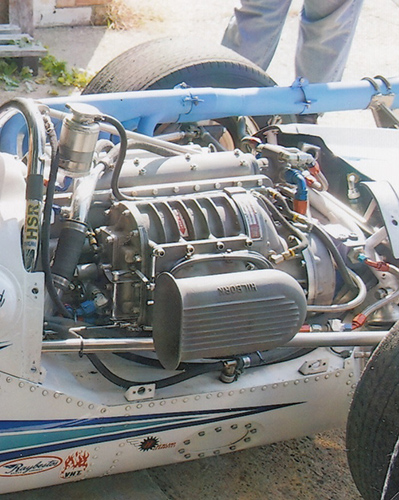
This is one of the original 1966 cars using a Roots-blown Offy, here seen in 2014. The car in question was Rodger Ward's #26 Lola-Offy. A retirement in what eventually turned out to be the final start at Indy for two-time winner Ward. The number of Roots-blown versions of the Offy at that time wasn't very high, surviving original cars are even rarer nowadays. (photo HG)
Altogether, for me it is difficult to imagine that Vaillante could get into the race with their underpowered car, let alone the two cars being faster than 30 other cars. To me, I still think the Vaillante looks to be very tiny and 'petite' compared to the other cars in the album. Having seen the engines of that era in person, and with the knowledge that this Vaillante was supposed to have a 3-litre V12 in the engine bay, I really wonder if the car is large enough to contain any of the actual engines of that time, be it an 4.2-litre Indy engine or a 3-litre V12 destined for F1 from that very same year of 1966. And I do not even mention the fact that somewhere in that tiny Vaillante room also had to be accommodated to store a substantial number of gallons of fuel.
By the way, another car that debuted in the Suspense à Indianapolis adventure reappears in this legende. One example of the prototype used in the first two races of the 'Championship of the United States' is the car for daily commuting and other duties for Steve and Michel. Quite a downgrading of status. Compare this for example with the Ford GT40 of the Texas Drivers it raced against in those two events. The GT40 went on and became a Le Mans and sportcars legend…
A bit more about the Vaillante team during May in the lead up to the race
As this album is so new, I don't like to spoil too much about the contents of the plot but I need to tell at least a bit in order to present you the final conclusions I made about this album.
The Vaillante team is present for the entire Month of May but arrives shorthanded in support crew. Eventually they run into a female who is qualified for the job and she joins the team. But from then on, several of the team members get unwanted attention from some questionable people. Shortly before the race after a major incident, the girl admits to being the reason for all of this unwanted attention but she refuses to tell everything. She does leave Team Vaillante in order to end all the disturbances for the team because of her presence.
Then: the race
Again, if it comes to historical accuracy, the authors don't disappoint, at least not initially. The race in the story is following the script of the actual race. The only things that are different from the actual race is that Steve and Michel and this Larry Djim are part of the race instead of three other drivers. And since in the story Michel and Steve qualified on the front row, we see neither Jim Clark nor George Snider (the actual second and third fastest qualifiers) in the drawing of the front row that appears in the novel.
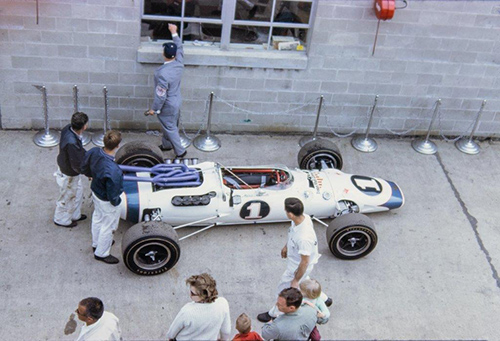
In the album as well as in the original race, the polesitter was the same: Mario Andretti drove this car, the first of the Hawk-Fords. (photo copyright Jim Edwards Collection, provided by Bill Ashby, used with permission)
And there is one other detail difference I will get into later on.
Steve is an early retirement in the race but then runs into the girl that had been part of the team and she urges Steve to have Michel warned about Larry Djim. Michel races in the company of Jim Clark and in the closing stages of the race this Larry Djim tries to eliminate both Clark and Michel, but he fails. Like in the real race of 1966, Graham Hill and Jim Clark finish in the first two places, Michel eventually finishes third. But the race ends in confusion, just like in the real race because of the question whether Graham Hill truly won the race or not.
And now we come to the reason for the creation of this story, because authors Denis Lapière and Vincent Dutreuil offer an explanation for that.
In website announcements about the new Michel Vaillant Legendes it is said that the series will try to explain what really happened in some of the world's most legendary races. The album has something of a disclaimer in which it is said that the story is a mixture of the authors' fantasy and reality. And so, maybe it is better not to take the initial claims of the intentions of the Legendes too seriously, definitely not for the full 100%.
In the album, after the race has ended, the former time-keeping girl shows up again and tells what has happened behind the scenes and what kind of plot she was supposed to have been part of, revealing that organised crime from the gambling world tried to make sure that either Graham Hill or Jackie Stewart should win the race. The fictitious driver Larry Djim was also part of the plans.
That is the least innocent activity and part of the plan to achieve in the story.
On thin ice
There is some discussion in the album between the track officials and the duo of Colin Chapman and father Henri Vaillant about the scoring situation in which Graham Hill is shown to be in the lead all of a sudden. The officials are very reluctant to backtrack on their decisions and suggest to Chapman and the elder Vaillant to file an official complaint. Reading several comments given by the girl about what supposedly went on in this race, one could start to think that at least somewhere in the race organisation some assistance was provided to Hill but no names or official functions are listed so nobody can be blamed, be it a fictitious or a real person. But not all participants in the race get away with that that easily.
A casual reader probably won't notice but for people with a deep and sincere interest in the history of the Indy 500, there is a twist in the entire story that is quite harmful to one driver in the 1966 race and potentially tainting his reputation badly as soon as you dive deeper into the actual history, and this while he is no longer in a position to defend himself.
It is described very innocently by the girl as she tells her story after the race. She mentions rather casually that the first-lap accident that took place (in the scenario, and entirely inspired by the actual crash) was on purpose in order to eliminate a number of top contenders instantly and enhance the chances for victory for either Stewart or Hill since according to the girl's explanation, both these men would remain safe. After reading this particular drawing my jaw dropped.
The girl gives no names or explanations as to how the crash was organised and which driver(s) was/were involved with it, but because of her statement that the crash was on purpose all attention given to the start crash gets an entirely new meaning with far lasting consequences.
The starting accident does indeed appear in the album with fairly accurate drawings but also with a short yet fairly accurate description of how it started.
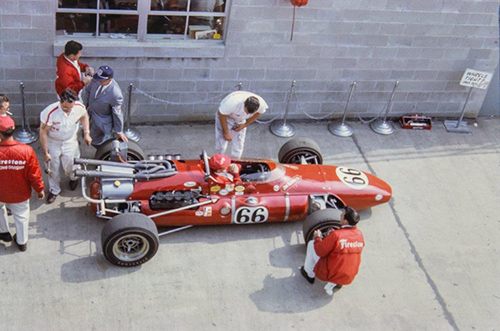
One of the cars appearing prominently in the drawings of the startline crash is inspired by this car. One might assume that both car and driver had a prominent role in the crash but that is not really the case. In the drawings car and driver remain unidentified. The car in question was a Vollstedt-Ford and driven by Cale Yarborough.
(photo copyright Jim Edwards Collection, provided by Bill Ashby, used with permission)
It is followed by another drawing with yet another fairly accurate description of how it all started. But in these descriptions only one driver is named, a driver who was part of the starting field that year. On both occasions he is said to have started off the accident. No single other driver's name is mentioned as being involved in the crash, the only named mentioned in the text (twice) is that of Billy Foster. In the drawings of the actual accident it is mentioned that 'Foster was tangling', on the second occasion the accident is described as having started with Foster hitting the wall. No excuse is listed as to what caused all of this, no talk about a mechanical failure or being blocked all of a sudden, nothing of the kind. Foster simply gets the blame for having started all the mayhem, which at first sight is still rather innocent. However, later in the story, once the girl has revealed that the crash was deliberate, the consequences of putting the blame on Foster's shoulders and his alone take on an entirely new dimension.
The general consensus about the 1966 start crash is that one way or another it indeed started with Billy Foster hitting the wall. But although all kind of accusations have been made to Foster for driving dangerously and taking too many risks too early in the race, there have never been any suggestions about him having caused the crash on purpose.
The authors obviously wanted to stick to the truth as close as possible so they still had the accident start by Foster's crash. Nothing wrong with that. But subsequently they also made the accident part of the plot with which this album was created. These two facts combined yield a highly unsettling result.
I don't think that it was their intention to do so but as things have been written down in the story it does suggest that Billy Foster was part or the big plan organised by the gambling syndicate to enhance the chances to see either Stewart or Hill win the race, thereby directly linking Billy Foster to organised crime.
I doubt if it will be a matter of concern for the average reader of the story. But big-time Indy fans with a crush on Indy history may feel uneasy about this. Being declared guilty to starting the biggest crash in Indy history that took out the largest number of cars in one single accident is one thing, but suggesting that this crash was caused deliberately as a result of having connections with organised crime?
I can't help feeling very uneasy about this part of the story and really wonder why the authors enabled having such thoughts about a genuine driver who was part of the race.
In the aftermath of the accident as it happened, Billy Foster was hit by a lot of criticism, and this did to some extent hurt his career and how people looked upon him. Regrettably for him, he had a short time to deal with all of this since less than a year later he was killed in a practice accident for a NASCAR race at Riverside.
But do you remember what has happened to Kevin Cogan since 1982?
For the non-Indycar fans: heading for the green flag in the race of 1982, Kevin Cogan somehow lost control over his car (he started at the middle of the front row) he first hit his neighbour on the right (none less than AJ Foyt) before crashing into Mario Andretti, so in one crash he ran into the two of the most popular and best known drivers, the biggest heroes among the race fans in the Indycar scene. The race was redflagged, Cogan and Andretti were instant retirements, Foyt needed to repair his damaged car for the restart. The accident also ended the race for Dale Whittington and Roger Mears. Many die-hard Foyt and Mario fans keep bringing up this '82 crash in order to defend their negative feelings towards Kevin Cogan. Very negative things have been said about Cogan ever since that fateful moment in his career, not in the least because of comments by both Mario Andretti and AJ. Foyt made in the heat of the moment after the crash and broadcast on TV.
Alright, the 1966 crash wasn't live on TV and circumstances were a bit different compared to 1982 but nevertheless, one could wonder if Foster's career would have been affected by the 1966 crash if he had survived Riverside '67, with people possibly dragging up '66 again and again and again.
This write-up is definitely not intended to become a detailed analysis about the 1966 crash with an attempt to pin down the guilty driver(s), and neither it is written to absolve anyone involved from their share in the entire affair.
Nevertheless, since Billy Foster is given a very rough treatment, with even some unconfirmed accusations being made, it is fair to dive a little deeper into the aftermath of the 1966 crash and the results of the crash investigations that were carried out. Details of those results were printed in several publications, and some have been reproduced and quoted in a book about Billy Foster entitled Billy Foster, the Victoria Flash by Bob Kehoo.
Kehoo cited two sources, the first of them David Overpeck, printed in the Indianapolis Star on June 3rd. Overpeck had attended a special screening of motion pictures of the accident and his opinion after watching the footage was that:
“It would be wrong to attach any blame to the actions of either Foster or Boyd. The green flag was out and the race was on. Both were racing and both went for the same hole.”
Kehoo continues by citing a notice that appeared on July 2nd in the Competition Press newspaper, entitled 'USAC lifts Indy Blame from Foster'. The opening lines read:
INDIANAPOLIS, June 12 – Blame for the multiple first-lap crash in the memorial Day 500 cannot be attributed to anyone driver. In a special bulletin released by USAC Director of Competition Henri Banks concluded that the first-lap incident was not the fault of any specific driver, but rather the result of a number of circumstances in which no one could be blamed directly. Many hours were spend by top USAC officials repeatedly viewing several motion picture sequences of the wreck, in slow motion and frame-by-frame.
The article continues with a description of circumstances and facts related to the accident. But there is one more comment that deserves to be reproduced here:
“USAC officials are reported to have said that the greatest regret, apart from the accident itself, was the attitude of several drivers in trying to pinpoint the blame onto one driver before the facts were fully known and studied.”
Since Dans l'enfer d'Indianapolis contains a number of negative comments and even some daring and unproven accusations towards him, I think that it is warranted to include the above details about Billy Foster that do not appear in Dans l'enfer d'Indianapolis.
There is no denying that Billy Foster was a major factor in the explanations as to what caused the accident, but he was cleared of any wrongdoings either by driver error or on purpose within weeks after the actual accident, making a possible accusation of him having caused the accident on purpose because of links to organized crime even more painful and hard to understand.
The novel ends shortly after the race weekend, time-wise before June 12th when USAC's conclusions were printed, so it was impossible to introduce them in the story as printed. But given the unsupported and serious accusations made to Foster I think that it is warranted to include the results of the official USAC investigations in this writing, despite the fact that they became known beyond the timeframe in which the novel took place.

The car driven by Billy Foster in the 1966 Indy 500 was this Vollstedt-Ford, it was to be Billy's second and final drive at Indy. Qualifying for the race the year before, Foster became the first Canadian driver to race in the Indy 500.
(photo copyright Jim Edwards Collection, provided by Bill Ashby, used with permission)
Now: about causing a deliberate crash in order to eliminate as many drivers as possible to enhance the chances of victory for two other drivers, drivers who needed not to be involved in that crash one way or another to begin with.
Billy Foster had qualified of the fourth row, outside spot. On his left was Jackie Stewart, right behind him was Graham Hill. And according the girl's statements about the reasons of a deliberate crash, these two drivers were not supposed to be affected. Personally, I think the odds on such an action succeeding as intended were not very high to begin with, as it would have required an awful amount of luck for things to go as planned.
A description of what actually happened during the start of the 1966 race can be found in the book Autocourse Official History of the Indianapolis 500 by Donald Davidson and Rick Shaffer, two authors with a name and reputation to lose. In the chapter about 1966 it reads the following about Foster's driving:
Behind them there was melee. Starting on the outside of Row Four, Billy Foster, who later claimed that he was bumped, clouted the outside wall along the main straightaway as he tried to squeeze by Johncock, who had started on row 2. Foster had the advantage of a five-speed gearbox while Johncock's car had a two-speed. It might have been a one-car accident had one of his right side wheels and his nose cone not bounced in front of the oncoming pack of cars.
The 1966 Clymer Yearbook Race report contained the following statement given by Foster:
"All I know is that someone hit me on the right rear and I ended up going into the wall. I guess that started the whole mess."
Foster asserted that he had already passed Johncock when he was passed, forcing him toward the outside into a collision with Johncock. Foster could not say who it was that tapped him.
If authors Lapière & Dutreuil have read any of these comments during their research, is the driver who Foster claimed hit him perhaps the man they envisioned to have connections with organised crime? But then why not make one single reference to that driver? Anyway, mentioning drivers' names in the drawings of the crash wasn't absolutely necessary, and the authors had several opportunities to still name Foster as involved in the crash yet giving him a good excuse for the way he got involved in it, with or without introducing an imaginary driver. But regrettably, they didn't.
Then the criminal plot the authors had come up with and as it was revealed by the girl has a flaw. During her confession she states that it was to enhance both Stewart and Hill's chances but in the story the girl infiltrates in the Vaillante team on Opening Day correctly dated Saturday April 30th. She started to work for the team the next day. In reality plans for framing the race could only have been made because of Jackie Stewart's participation alone, as on Opening Day it wasn't yet known that Graham Hill would be at Indy that year!
Jackie Stewart had been signed up by John Mecom to drive a Lola-Ford that year. One of his teammates was to be Walt Hansgen but he crashed to his death during the Le Mans test weekend in early April. Only on May 3rd it was announced that Graham Hill had been signed up as Hansgen's replacement. So the gambling syndicate could not have made their plans to fix the race to have either Hill or Stewart as the winner before that date. If their initial plan was based on the participation of Jackie Stewart and the other rookies entered that year, they certainly must not have believed their good fortune, because while they were committing to their plans, all of a sudden a driver of the calibre of Graham Hill was entered as well! Given the statements of the girl, Graham instantly became one of the two priority drivers to benefit in order to allow the syndicate's plan to succeed.
The album closes with a strong suggestion that the end result of the race was indeed fixed, with Graham Hill credited with extra lap that put him ahead of Jim Clark and Michel Vaillant.
Donald Davidson and Rick Shaffer tell the readers in their book that Timing & Scoring had made an error caused by the fact that the two Lotus cars looked nearly identical. A review of the data proved that a lap to Jim Clark was actually by his team mate Al Unser (who at that time did not yet need to refer to himself as Sr). Over time this explanation became ever more accepted as having been the case. Something that didn't help either was that apart from being nearly identical in colours, the numbers of both STP-Lotus cars were very similar too: 18 and 19.
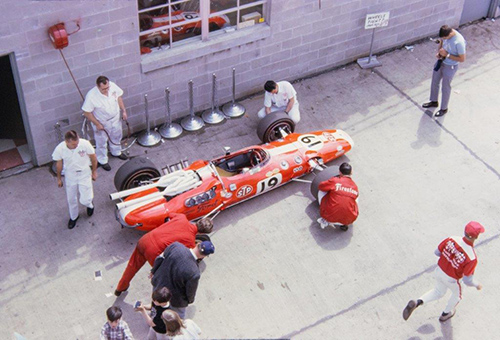
In the album Jim Clark is banned from the front row where he did qualify this car at in the real 1966 race. Later on, he and his car do appear in the story in scenes that resemble if not duplicate actual events.
(photo copyright Jim Edwards Collection, provided by Bill Ashby, used with permission)
In the album the scenario of taking away a lap from Jim Clark was difficult if not impossible to reproduce for Lapière & Dutreuil, because if a lap from Al Unser had been credited to Jim Clark and this was corrected by taking away a lap from Clark, then the same had to happen to Michel Vaillant, as Clark and Michel are told to be lapping together during the final stages of the race. But how could Michel have been given a lap that he had not driven yet?
That would really have taken some brain gymnastics to come up with an vaguely acceptable explanation for such a thing to have happened. (There was no near identical car in the field that could have assisted in giving Michel a lap he had not driven yet.)
On the other hand, giving Hill an extra lap one way or the other takes a bit less fantasy to arrange. But if it comes to the Internet claims in the announcement of the upcoming album that the adventure would explain what really happened, I think we can safely say by now that this can't be the case, because in the real 1966 race Graham Hill was not given an extra lap, Jim Clark lost one instead.
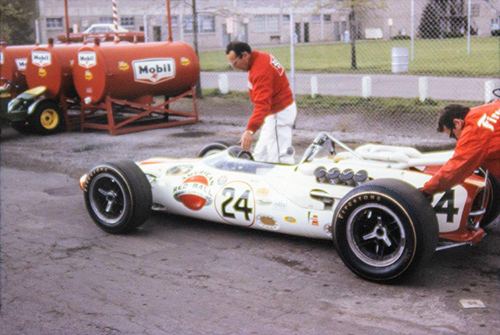
The winner of the 1966 Indy 500 both in reality and in Dans l'enfer d'Indianapolis was this Lola-Ford T90 owned by John Mecom. (photo copyright Jim Edwards Collection, provided by Bill Ashby, used with permission)
So is the entire scenario as created by the authors pure fantasy and totally unlikely to have taken place?
I don't dare to say it was 100% impossible. (If you ask me, that is a sad conclusion to make to begin with.) There have been more rumours about drivers getting in trouble with organised crime and needing to 'help out' with something happening on track in order to settle their gambling debts. One of the most famous claims that went around as gossip is that Ed Elisian had to lead the first lap in 1958. I write this down as being gossip, as I have not the slightest proof that this was indeed the case.
As for the organisation and officials at IMS being vulnerable to blackmailing, I have never heard anything that has been proved to be the case, although there have been a few other controversies regarding the final results of the race up until 1966. The most recent case of debatable decisions by officials curiously was one that had also affected Team Lotus.
In 1963, chief steward Harlan Fengler proclaimed during the pre-race drivers' meeting that he would throw black flags on cars leaking oil: "If you don't believe me, test me" was his outspoken and fierce statement. And indeed, on Race Day, when an oil spill was discovered in the pitlane after Jim Hurtubise had made a stop for fuel and tires halfway into the race, Fengler instantly took out his Novi out of the race, blackflagged because of an oil spot in the pitlane put down during a stop, so not on the actual track.
But when later on in the race it was clear that leader Parnelli Jones was leaking oil while lapping the actual track, that black flag wasn't thrown instantly. When the car appeared to have stopped leaking oil Jones was permitted to continue and went on to win the race. However, according to the drivers, two late race spins were a result of the oil leaked by Parnelli Jones. Had Jones been blackflagged, Jim Clark would have won the race in his Lotus. Now, Lotus and their 'funny car' were intruders challenging the establishment while Jones drove for well-known and powerful team owner JC Agajanian, a big name in the USAC ranks.
There is no solid evidence against Fengler having manipulated the 1963 race but it remains strange that during the race he used different yardsticks to determine which kind of oil leak was dangerous enough to take a car out of the race while going against the warnings he had given himself before the race.
Let's describe this carefully: there have been moments in the Indy 500 history in which questionable events took place, but it has never been proven that these were deliberate or planned. But it isn't that strange that in some cases eyebrows were raised.
The criminal plot as created by Lapière & Dutreuil in Dans l'enfer d'Indianapolis did indeed result in the thing that made the 1966 race quite remarkable in Indy 500 history up till that moment in time and as such, it adds to the story.
But has the actual truth or at least a part of what really happened at Indy on Race Day 1966 been revealed in this album? Make up your own mind.
Nevertheless, there is one thing in which I think Dans l'enfer d'Indianapolis is a qualified success, as in its own way it brings back the scenery and atmosphere of 1966 at Indianapolis. It is a interesting piece of printed matter about that event, even if not entirely true.
A few other observations about the story
The album has two things I can mention that probably would have been different in a Graton album. The first is about a person who has appeared in Graton-drawn albums on several occasions already.
When the girl (before the race) explains at least to some extent why she is leaving the Vaillante team she hints to being unwillingly involved with organised crime and is actually in possession of evidence. She is suggested to hand that over to the FBI but her answer is that this makes no sense as the FBI is only interested in finding communists and proclaiming that organised crime does not exist in the US. The FBI hunting down people in support of let's say not far enough right-wing oriented citizens if not actually outspoken left-wing supporters during the mid-sixties is indeed a true observation.
However, in three of the first eleven Michel Vaillant albums (one of them Suspense à Indianapolis) a friend of Steve Warson appears. This friend whose name is Eddie McGrath works for the FBI and has helped out Steve and/or Michel on at least two occasions. One could envision Steve remembering his old friend and suggesting to get in touch with him in order to help the girl he is kind of attracted to. But nothing like this happens, Eddie McGrath is not introduced in Enfer.
There is, however, one famous name not represented in this story that possibly proves even more why Dans l'enfer d'Indianapolis can not be a Jean Graton album.
If we blend this album into the timeline of all Michel Vaillant albums, it would be directly behind Suspense à Indianapolis or Graton's first album following Suspense. It would be the third adventure of Michel and Steve taking place at Indianapolis.
In the two previous Indy adventures Graton gave an important role to the Novi cars of that particular moment of time. Graton was fascinated by the Novis and went quite far in this. For the second album (Le pilot sans visage, released as an album in 1960) he needed Steve Warson to be driving in an American-built F1 car. Graton created such a car which was named Novi Europ and it was entirely fantasy. In the real world there was absolutely no chance that any of the people related with the real Novis, let alone the team, would be involved with an F1 project. (The answer to the question of why not: Le pilot sans visage took place in 1958 or 1959 and the then current team owner of the Novi outfit, Lew Welch, concentrated his racing efforts on Indianapolis only. By then his team started to become handicapped due to Welch running into financial problems. Even if he was interested in getting involved in F1, Welch could no longer afford starting up such an F1 project. His financial issues forced Welch to sell off his cars and engines in 1961 to new owners.)
There was still a Novi in 1966 but it had been a close call. Since 1961, the assets of the Novi team, primarily the engines and some front-engined chassis with either rear-wheel drive or (since 1964) 4WD were owned by the Granatelli brothers. For 1966, they were planning to park the Novis and enter a 4WD car powered by a turbine engine instead. When the chassis of this car was damaged beyond repairs in a fairly early stage, the brothers went back to their last built Novi-powered 4WD chassis and modified that to some extent in order to achieve a weight distribution similar to what their turbine contender would have had. It was hoped to at least gain some chassis experience with a car with such a weight distribution. It was still front-engined and the power output of the centrifugally supercharged Novi V8 engine was 837hp, a staggering amount for the time. It was a monster and looked like a monster too. Yet it failed to qualify after difficulties to get the car up to speed. A crash in the last weekend of qualifying spelled the end for the Novi that year. And as history would prove, the end of the Novi for ever.
Given the monstrous appearance of the 1966 Novi, and knowing the soft spot for the Novi that Jean Graton had, I am near certain that if he had had any involvement with the scenario of this album, he would have found a way to add at least one drawing featuring the 1966 Novi. But nowhere in the album, despite the number of different cars we get to see that were indeed at Indy in 1966, including a few that failed to qualify, the 1966 Novi does not pokes its long nose into at least one drawing, let alone is mentioned as being around as well.
In that respect this album breaks with the tradition of the Graton albums with regards to Indy adventures taking place during the Novi years.
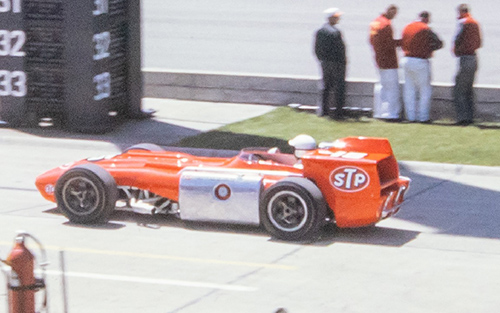
One of the versions of the 1966 Novi at the Speedway. It was a monster to see. This is the shortnosed version, it was also driven with a longer, more streamlined nose, making use of the fact that the car no longer carried no radiator in the nose. Instead, this was located in the box on the tail of the car. (image cropped from an original photo, copyright Bill Ashby, used with permission)
There is something unusual about this Novi. The chassis was built by Vince Granatelli Sr. in 1965 and was fitted with a 4WD driveline supplied by Ferguson Formula in England. The 1964 4WD car had been entirely built by Ferguson and was the type P104. A manufacturer or another name for the 1965 car was unknown but the driveline as supplied was registered as P126 in the Ferguson Formula archives. Redundant Novi information from a Novi fanatic included in one of his write-ups yet again? You will find out later on why I do mention these details.
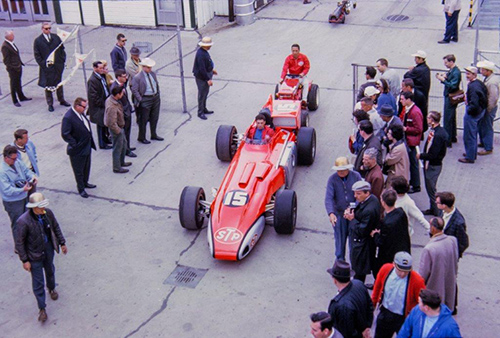
And another shot of the 'last of the Novis', here in its longnose version. Reputedly the car as we see it here had some 837hp at its disposal, yet that was not enough (or too much?) to qualify for the race. Taking in mind the appearances of other Novis in the Graton-drawn albums, one would think that one of these versions of the last-ever Novi was inspiring enough for the authors to make it into Dans l'enfer one way or another. (photo copyright Jim Edwards Collection, provided by Bill Ashby, used with permission)
There is another break the authors had to make with the Graton albums, as Graton had made Michel the 'Champion of the United States' in the 1965 adventure Suspense à Indianapolis. One year later Michel was back at Indy, so one could argue that in order to follow the Graton albums Michel was entitled to use the #1 as the defending champion, both at Indy and in the championship Indy was part of.
However, that 'Championship of the United States' was an imaginary series while Dans l'enfer d'Indianapolis was solidly based on the truth. Indianapolis was part of the USAC National Championship and in 1965 Mario Andretti had won that title, and so was entitled to use the #1 the following year. His car indeed wears the #1 in the album.
There is yet another oddity in the album, as early on Michel and Steve are said to be former champions and as such are not obliged to take part in the mandatory rookie tests. But near the end of the story when the timekeeper reveals the plans in which she was involved, she mentions how the criminal gang that she was associated with wanted a rookie winner, since such had not happened in the past 40 years. In the real world, before the 1966 race, that was indeed the case, as George Souders was the last rookie winner at Indy in 1927. But in the parallel Vaillante universe of its hero Michel created by Jean Graton, the girl's statement can not be correct because by saying so the fact that Michel won his debut 500 as told in Le Grand Défi (in either 1957 or 1958) is entirely overlooked. This would make the bare reason for the criminal plot much less obvious as there had been a rookie winner less than ten years before!
Then there is another detail worth mentioning, as the info booklet released by Altaya about the 1965 Vaillante 'Spéciale Indianapolis' explains that the car was built as an experimental laboratory for Vaillante to test their upcoming new 3-litre V12 F1 engine. The 3-litre engines had made their appearance in F1 in 1966 but does Dans l'enfer contain any references to the F1 season? No it doesn't, and this despite the fact that the first GP race of the 1966 season took place in the weekend before Memorial Day weekend in the US. But still, there is not the slightest hint to the fact that Michel and Steve have to race in Monaco and give the Vaillante V12 engine its debut in the racing series it was created for.
The imaginary Indy 500 Record Book being rewritten yet again, and the consequences of that
So yes, despite the fact that Vaillante did not win the race, participating in the 1966 Indy 500 would have rewritten the imaginary Indy 500 Record Book, at least if we use the Dutch translation of the album, because on page 6, Steve makes a comment about the carburettors on his car.
That would make the Vaillante 'Spéciale Indianapolis' the last-ever car fitted with such devices, as they took that distinction from the 1963 Lotus cars that had been the last-ever carbureted cars to race at Indy.
Even funnier are the implications of this knowledge, as in general it is an accepted fact that engines can be more powerful when fitted with fuel injection instead of carburettors. But according to the Altaya information booklet that came with the scale model of the 1965 'Spéciale Indianapolis', the car used fuel injection! So why such a step back in technology? In fact, it's a reversal of the modifications done in the late 50s adventure Le Grand Défi when the Vaillante Grand Prix was prepared for competing at Indianapolis, as for that occasion the engine was fitted with fuel injection!
About some of the real 1966 cars today
In Dans l'enfer d'Indianapolis the majority of the cars did indeed exist, a number of them until today. In several occasions they were restored to their 1966 spec. A few of those I got to see for myself, so for the sake of entertainment or your opportunity to have a look, here are some of them.
Jim Clark had won the 1965 Indy 500 and his winning Lotus 38/1 was claimed by Ford to never race again. In 1966 Clark drove another 38, the 38/4 that was supposedly driven in 1965 by team mate Bobby Johns. This particular car has survived and in the late 80s and early 90s was restored into its 1965 specification and colours.
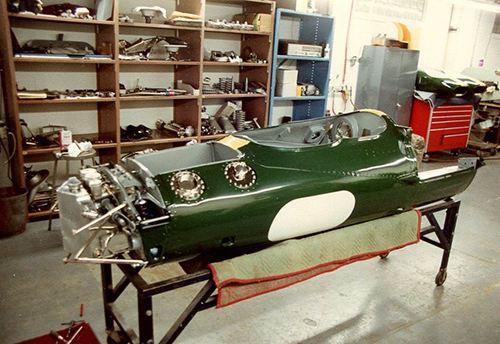
Seen here in May 1990 when the restoration of 38/4 as the #83 of 1965 was still in progress. (photo HG)
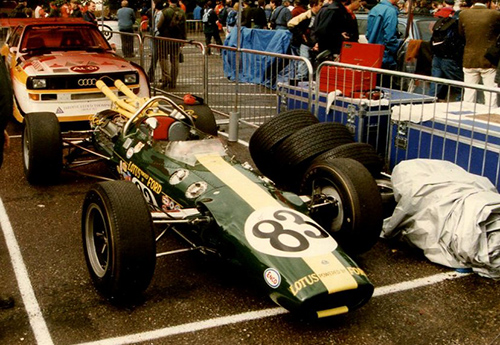
The same car after its restoration had been finished made it to the Goodwood Festival Of Speed in 1997. (photo HG)
At a moment unknown to me the car changed ownership and the new owner had the car repainted in the 1966 colours. I got to see the car in its new colours in May 2016, but not at the best moment for a photograph.
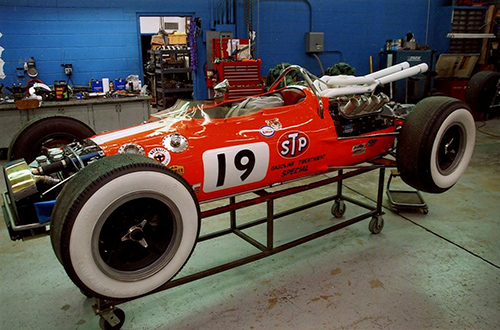
An old friend of mine, redressed in what for many are its most glorious colours, here seen in May 2016 going through some maintenance work. (photo HG)
Jackie Stewart and Graham Hill both drove Ford-powered Lola T90s entered by team owner John Mecom. Mecom entered a third Lola T90 that differed from the other two cars because of its engine. It was fitted with a Roots-blown Offenhauser engine and was driven by two-time 500 winner Rodger Ward. Ward qualified the car but retired due to handling problems and instantly announced his retirement from racing. The car was used for some time but after a heavy crash retired as a wreck. In the early 2000s the car was rebuilt into its 1966 specs, including the very rare Roots-blown Offy engine. Engine-wise the car was a rarity in 1966. In later years, the number of surviving Roots-blown Offy-powered cars diminished even more, making this car unique among its surviving peers of that era.
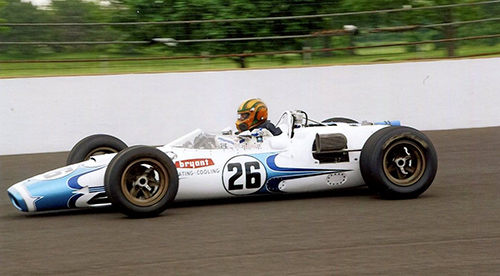
Seen here on the day before the 2016 race, the restored Lola T90 with supercharged Offy during its demo laps for veteran cars organised that day. (photo HG)
1966 was the first year for the Eagle cars, the brand found by Dan Gurney. Gurney drove a car himself but was one of the victims of the start crash. Supposedly his car has been saved from oblivion and was restored to the 1966 Indy trim. Restoration was finished in August 2018.
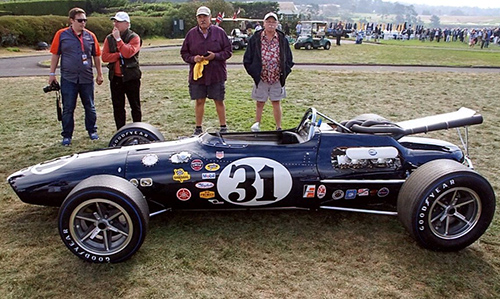
Seen at Pebble Beach 2018, what is believed to be 'the first car that Dan built and drove at Indy'. (photo HG)
1966 was also the year that the first Coyote was raced at Indy. The brand was founded by AJ Foyt, at that time still only a two-time winner. In many ways it was a copy of the Lotus 38 with a few detail differences. Foyt practiced the car but after an accident in the first qualifying weekend he parked the car and qualified a Lotus instead. Eventually this car was also restored and the owner opted for likely its most significant configuration, that of the very first Coyote ever at Indy.
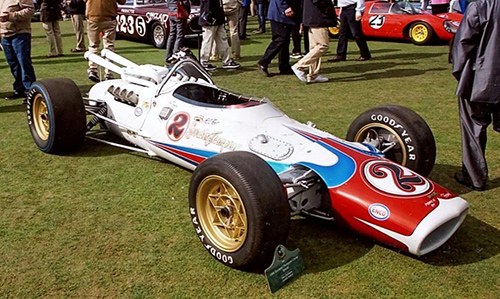
Seen at Pebble Beach 2018, what is believed to be 'the first car that AJ built and drove at Indy'. (photo HG)
Then there is yet another 'first of the breed' to show, as Mario Andretti's Hawk-Ford with which he won the pole in 1966 was also the first of the brand. But unlike the Eagle and Coyote shown already, the Hawk was no brand new car, as it had raced at Indy in 1965 already. This is not the right place to tell you the story about how this particular Hawk lived on but nowadays there is a car that can be seen as what once was Mario's car at Indy in both 1965 and 1966.
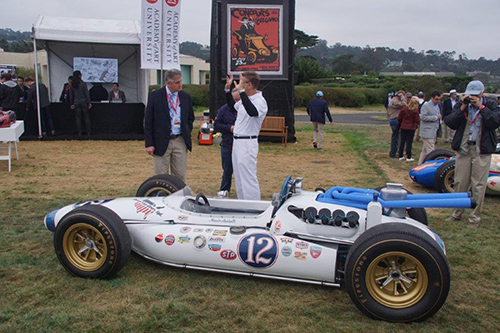
Seen at Pebble Beach 2018, the first of the Hawk cars made famous by Mario Andretti in his early years at Indy. This chassis was the car he used to win pole in 1966, although it is presented here as it looked in 1965 when Mario finished third and won Rookie of the year honours. (photo HG)
And then I have two more cars to mention.
At least one other car still survives in the trim it carried in 1966, the #39 Watson roadster with turbocharged Offy qualified by Bobby Grim for the race. Built in 1963, it was entered as the #46 by the Racing Associates and among Watson followers it is generally numbered as the 21st built chassis. The car was not qualified for the 1963 race but one year later it was driven by Johnny Rutherford and part of the second-lap disaster. It failed to qualify again in 1965 but was the slowest qualifier in 1966. Regrettably, the 21st Watson appeared to have a sense for being involved in multiple car crashes. After having been part of the 1964 second-lap disaster, it was one of the 11 victims of the start crash that marred the 1966 race. So in four years at Indy it qualified only twice, both the years in which multi-car crashes took place, and the car was part of these crashes in both years. As a result it officially registered only two laps under Race Day conditions (the two laps it did in 1964). Nevertheless, the car became a significant car in Indy history because in 1965 this was the mule chassis used by Herb Porter for his experiments with the first turbocharged Offy engine and proved the long-term potential of such a project. Turbo Offy power was the key that got the car qualified in 1966, be it as slowest in the field, but in doing so it made history as it became the last-ever of the classic front-engined roadsters ever to make an Indy 500 starting field. (No insult intended to the Jim Hurtubise and Mallard fans because of 1968.)

The graphic novel reviewed and analysed in this writing was announced early 2022 and published late 2022. One of the cars appearing in this 2022 novel is seen here on a location where is was exhibited for a while during that same year, as part of an exhibition at the Indianapolis Motor Speedway. (photo John Darlington III, used with permission)
But this car deserves to be mentioned for another reason.
We already saw that there were three cars that appeared in the Graton album Suspense à Indianapolis and also made it into Dans l'enfer d'Indianapolis, all of these three cars being Vaillantes: the two race cars and the GT proto that was raced in Suspense and a passenger car in Dans l'enfer. There is, however, a fourth car that appeared in one Suspense drawing and also made it into this 2022 album.
On page 43 of Suspense, in the left drawing on the second row we see two roadsters from behind, numbered 16 and behind it the 46. The image is inspired by a picture on page 138 in the 1963 Clymer Yearbook in which two cars with the same number appear. This #46 was the Racing Associates entry of 1963 and eventually became the 1966 turbocharged #39 Watson in 1966 and in Dans l'enfer. Therefore this particular car is the only car that truly exists that made it into both of these two graphic novels.
There is one car that was at Indy in 1966 left to mention, and to some extent it is partially living on today. It failed to qualify for the 1966 race, as I already mentioned and showed in pictures.
The career of the Novi was over for good after its 1966 DNQ and research learned that the last-ever Novi was canabalised for parts and then destroyed. Further research also learned that the other 4WD car (Ferguson P104) was partly canabalised, with components used in another Indycar that wrote history and caused controversy. However, for their book Traction For Sale (the story of Ferguson Formula four-wheel-drive) authors Bill Munro and Pat Turner found out that during its life after being retired the P104 had retained its original driveline. And so, if the story that this later Indycar had used a Ferguson 4WD driveline with components taken from a Novi was still correct, it had to be the parts taken from the 1965-built car and as a consequence be P126 components.
Which means that at least some parts of a car that never made it into Dans L'enfer d'Indianapolis but almost certainly would have been in the story if Jean Graton had been involved with it, as some parts of that particular car still survive in another car. Because it is this car that became a legend in Indy history like few other cars.
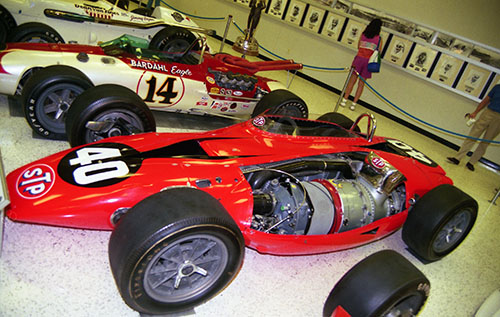
Yes, the legendary #40 STP turbine car that almost won the 1967 race had a 4WD driveline that made use of components taken from the canabalised #15 Novi of the year before. The Turbine car was on loan to the IMS Museum for a long time but, owned by the Smithsonean Museum, has gone back to its owners. Here it is seen while still on display at IMS Museum. (photo HG)
Final words
So, what to think about this album Dans I’enfer d’Indianapolis?
Maybe I am too touchy about the fact that it appears as if Billy Foster is accused of having links with organised crime and causing the starting accident on purpose.
So what if I ignore that fact?
Then I have to say that this album is an impressive publication. The research on the cars of that year, the location, the sequence of events in time, it is a job well done, very well done. I had to use several sources of information to find the few errors that I listed.
The quality of the drawings enhance the feeling of bringing you back to the Speedway in the mid-sixties, another job well done. For die-hard Vaillant fans the aforementioned small differences in style with the original Graton albums can be a bit bewildering on occasion, but if you are unfamiliar with that old style the authors certainly succeeded in providing a graphic novel that is a presentation of what it was like in those days.
OK, so the story is definitely not telling the 100% truth behind the mystery of Indy 1966. But as a story it has some acceptable backgrounds to work with to make up the scenario as printed. So altogether because of all these reasons I would rate this novel as a good one, even if not part of or linked to the Michel Vaillant albums, this album would also be great as a stand-alone album.
Having said that, there are two things that should have been done differently.
First of all, this imaginary driver Larry Djim should have driven a car that didn't use a number already in use on an actual 1966 Indy entry. Instead, it could have used colours and details that would have rendered it unlike any of the real cars of the year, just to make sure that Djim and his car fail to have the slightest association with any driver and car actually entered in 1966.
Most of all, it should have been avoided at all costs that a driver who started in the actual 1966 race was mentioned in the story containing a criminal plot while linking that driver with the organisations behind this plot.
Based on the actual positions at the grid, making a deliberate crash part of the strategy to achieve the goal of seeing a rookie winning the race was questionable to begin with. But if the crash had to be part of the criminal plot after all, then it should have been assured that no actual driver in the race could have been linked with the both the plot and the organisations behind it. Such could have been done by leaving out all driver names in the drawings related to the crash or by introducing a fourth imaginary driver and making him responsible for starting the crash. In whatever way, it should not have been allowed that the name of any driver of the 1966 race, in this case Billy Foster, one way or another, deliberate or entirely unintentional, is linked to some very serious accusations that turn one of the two saddest moments in his career from an utterly misfortunate moment into a criminal act.
I have made several attempts to contact the authors in order to sort out how the scenario came about and if they were aware of the consequences to Billy Foster's reputation. Much to my regret, none of these attempts yielded a snippet of success.
Nevertheless, we can safely assume that the authors never had the intention to allow such thoughts and accusations about a driver to happen, but it looks as if the full implications of a couple of lines in their story were obviously not fully realised or overlooked.
Then, for the Michel Vaillant fans, this is the first of the new so-called Legendes. Will there indeed be a follow up and if so, what will the subject be? On the very final page of the story there is talk between brothers Michel and Jean-Pierre about the upcoming Le Mans race. That would mean Le Mans 1966. Hmmm. What about the odds on comparing how at least during the similar timeframe we can see which comes the closest to the actual truth of Le Mans 1966: the movie Ford vs Ferrari released in 2019 or the Michel Vaillant Legende Number 2?
I can answer that question myself, as we have the 13th album of the series, Concerto pour pilotes, an event taking place in the days before a Le Mans 24 hours race and during the actual race. That album was released in 1968. It had, however, been published as a serial in the Belgian weekly TinTin in 1966 already, from January 18th to July 19th, in numbering that makes 66/3 to 66/19. This means that Jean Graton created it during 1965 but generally a Graton adventure is taking place the next year. Which in this case would make Concerto pour pilotes a 1966 adventure. That particular race is won by Michel and Steve for Vaillante, so if the next Legende is indeed about Le Mans 1966, it will be most interesting to see how the authors blend it into the line-up of original Graton albums.
But then, late June 2023 it was announced on MichelVaillant.com that the second of the Legendes was to take place in the calendar year of 1971.
But who knows, maybe we will see a future Legende deal with Le Mans 1966 eventually. That race had a controversy related to the final outcome that handsomely overshadowed Indy 1966 and has remained maybe even more of a talking point than the 1966 Indy 500 became.
Bibliography and references
Publications
The Dutch version of Michel Vaillant Legendes no 1. Dans l'enfer d'Indianapolis, Denis Lapière and Vincent Dutreuil
Dutch translations of the Michel Vaillant albums:
No. 1: Le Grand Défi (an English translation of this album released in 2007 was also used)
No. 2: Le Pilot sans Visage
No. 11: Suspense à Indianapolis
No. 26: Champion du Monde
Billy Foster, the Victoria Flash, Bob Kehoo, Independently published (2019) ISBN 10: 1797052446
I had access to copies of chapters 32 and 33 that dealt with the Indy 500 of 1966.
Used from this book were quotes reprinted from two printed articles:
article title unknown, Dave Overpeck, Indianapolis Star, June 3rd, 1966
'USAC lifts Indy Blame from Foster', author unknown, Competition Press newspaper, July 2nd, 1966
Floyd Clymer's Indianapolis 500 Yearbook 1966
The Clymer books were published by his own publishing company, located in Los Angeles, CA (USA)
Autocourse Official History of the Indianapolis 500, second edition - fully revised and updated, Donald Davidson & Rick Shaffer, Icon Publishing Limited, Malvern, Worchestershire (UK) (2013)
Eddie Called Me Boss, Dick Sommers, Warren Publishing Company, Indianapolis, IN (USA) (1979)
Novi, the Legendary Indianapolis Race Car, Volume Two: The Granatelli Years (1961-1966), George Peters & Henri Greuter, Bar-Jean Enterprises, Hazelwood MO (USA), (1998)
The Illustrated History of the Indianapolis 500 1911-1994, Jack C. Fox, Carl Hungness Publishing, Speedway, IN (1995)
The Watson Years, Gary Wayne, Witness Productions, Marshall, IN (USA) (2001)
Traction For Sale, the Story of Ferguson Formula Four-Wheel-Drive, Bill Munro & Pat Turner, Earlswood Press, Redhill, Surrey, (UK) (2019)
Altaya: Les voitures de Michel Vaillant, no 48: Vaillante Indy Special
This was a booklet released with the 1:43 scale model of the listed car, released by Altaya France.
'Ouderwets 'vrooaaaarrr' en 'vrop, vrop'', Frank von Hebel, Leeuwarder Courant, 18 November 2022, Nieuwsblad van het Noorden publishing group
A review of the Dutch edition of the album published in a Dutch newspaper
Websites
Michel Vaillant on Wikipedia
Vaillant fan club
Official Michel Vaillant website
OldRacingCars.com
Thanks to the Nieuwsblad van het Noorden publishing group for providing an online version of the their review of this particular graphic novel. Thanks to Mr. Rene Joosten for providing additional information used within this work. Special thanks to Mr Bill Ashby (Brownsburg, IN) for providing sources of information used in this work, as well as for providing images from the Collection of Mr Jim Edwards (Zionsville, IN) used in this piece. We express our thanks to Mr Edwards for the permission to use his images.
Special thanks to Mr. John Darlington (Carmel, IN) for providing helpful photo material used in this piece.
